|
Reputable
Rottweiler breeders have been working hard for years to educate other
breeders and potential puppy buyers to expect certain health
clearances prior to breeding or purchasing a Rottweiler.
Because of this, more and more breeders are clearing their breeding
stock for hips, elbows, hearts, eyes. The purpose of this
page is to help you to better understand the meaning of all the
numbers behind these dog's names.
OFA
The Orthopedic
Foundation for Animals, Inc. is the leading North American Registry
for health clearances. Located in Missouri, USA, the OFA has
genetic databases for Hip Dysplasia, Elbow Dysplasia, Congenital
Cardiac Disease, Autoimmune Thyroiditis and Patella Luxation for the
Rottweiler. Information on the registry and access to
their online database can be found at www.offa.org.
When radiographs are submitted to the OFA, they are reviewed by
three radiologists whose consensus determines the rating of the
dog. Most veterinarians in Canada are familiar with the OFA's
requirements for submission, but if your vet is not, forms can be
downloaded directly from the OFA website. In addition, the OFA
has a semi-open, searchable database. Semi-open means that all
passing results are listed, along with failing results only if the
owner has agreed to disclose both passing and failing results.
The database can be searched by name, registration number, sire, dam
etc. Results from animals whose owners have agreed to release
all findings have been reported in green, whereas others are in black.
Below are
examples of the more commonly seen OFA certificates for one of my own dogs:
|
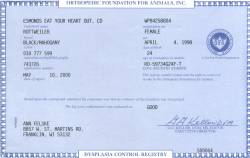 |
Hips - Blue Certificate
# RO-59734G24F-T
RO = Rottweiler
59734 is the number. This
dog was the 59,734th Rottweiler to get a number
G=Good (could also be E for
Excellent or F for fair)
24 = the number of months she
was at the time of evaluation (Min is 24)
F = Female (could also be M for Male)
T = Tatoo'd (newer forms will
say PI for Permanently Identified or
NOPI if the dog was not
Permanently Identified)
|
The OFA offers
three passing ratings for hips: Excellent, Good and Fair, one
transitional rating: Borderline, and three levels of Hip Dysplasia:
Mild, Moderate and Severe.
|
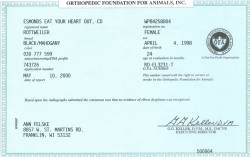 |
Elbows - Green Certificate
# RO-EL3231-T
RO=Rottweiler
EL=Elbows
3231 is the number. This
dog is the 3,231st dog to get an elbow number.
T = Tatoo'd (newer forms will
say PI for Permanently Identified or
NOPI if the dog was not
Permanently Identified)
|
Note: The
OFA offers only a passing certificate for elbows - No rating. A
failing report will include such information as whether the elbows
failed due to DJD (Degenerative Joint Disease, UAP (Ununited Anconeal
Process), FCP (Fragmented Coronoid Process) or OCD (Osteochondrosis),
whether they were Grade I, II, or III (in cases of DJD) and whether
the right, left, or both are affected.
|
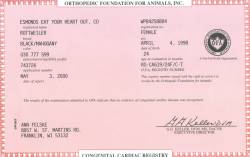 |
Cardiac - Pink Certificate
# RO-CA619/24F/C-T
RO=Rottweiler
CA= Cardiac
619 is the number. This
dog is the 619th dog to get an cardio number.
24 = the number of months she
was at the time of evaluation (Min is 12)
F = Female (could also be M for Male)
*IMPORTANT* C=Cardiologist
(Can also be S for Specialist or
P for General Practitioner)
T = Tatoo'd (newer forms will
say PI for Permanently Identified or
NOPI if the dog was not
Permanently Identified ) |
Cardiac is a
pass/fail test. It is important that this test be carried out
by a Certified Cardiologist, rather than a General Practitioner.
In the case of Cardiac Testing, the Cardiologist passes or fails the
dog. The OFA simply is a registry for this test and issues a
number accordingly.
The OFA also
registers results of Thyroid and Patella screening. As with
cardio testing, the veterinarian (in the case of Patella) and the lab
results (in the case of Thyroid) determines whether a dog receives a
passing or failing grade. Forms for these items read similiarly
to the forms above.
CERF
The Canine Eye
Registration Foundation is run by Purdue University in Indiana,
USA. CERF registers those dog's certified free of heritable eye
disease by members of the American College of Veterinary
Ophthalmologists (ACVO). CERF also offers a searchable online
database at http://www.vmdb.org
There is no minimum age for certification, however, CERF
Certification is good for one year only (as opposed to OFA, which is
good for the life of the dog) and it is suggested that each breeding
dog be re-cerf'd yearly to ensure that it has not showing signs of
heritable eye disease. Standards for heritibility vary by breed
and an item that is acceptable in one breed may not be in another.
|
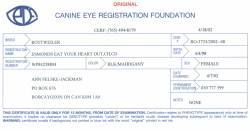 |
CERF - Small White Certificate
# RO-3733/2002-48
RO=Rottweiler
3733 is the number. This
dog is the 3733rd dog to get an CERF number.
2002 is the year that the
certification was done
48 is the number of months the
dog was at the time of certification
The fact that the dog is
Microchipped or Tatoo'd is not contained within the CERF number,
however, it is on the form in the lower right.
|
CHIC
The American
Kennel Club Canine Health Foundation now has an Information Center
that issues a CHIC number to dogs who have had all health tests
appropriate for their breed and have either passed or disclosed the
results of the testing. In the Rottweiler, the required tests
for inclusion in the CHIC database are Hips, Elbows, and Heart; as
certified by the OFA and eyes as certified by CERF. For
more information about AKC CHIC, visit their website at www.akcchf.org
A copy of the CHIC form is below:
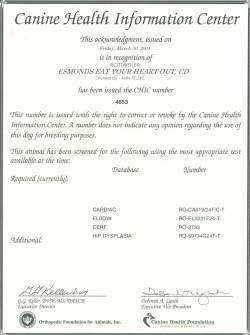
OVC
The Ontario
Veterinary Collage also certifies hips and elbows. Radiographs
are submitted to the OVC (at the University of Guelph) and evaluated
by Dr. Howard Dobson. It is on Dr. Dobson's evaluation alone
that the outcome is determined. The OVC utilizes a Pass/Fail
system for both hips and elbows, minimum age is 18 months. If a
dog passes, it is issued a certificate and a number. At this
time, the OVC does not offer a searchable database, although they
hope to offer this in the future. At the current time,
neither passing nor failing results are disclosed without the written
consent of the owner. Because of this, it is important to
view the original documents when it comes to OVC clearances.
The OVC website can be found at
http://www.ovc.uoguelph.ca/
PennHIP
PennHIP stands
for the University of Pennsylvania Hip Improvement Program.
Their technique assesses the quality of the hips and measures hip
joint laxity in an attempt to predict the incidence of Clinical Hip
Dysplasia. Three separate radiographs are made during an
evaluation and all results, passing and failing, are submitted to
PennHIP for inclusion in their database. PennHIP claims to be
able to reliably assess the hip laxity as early as 16 weeks.
PennHIP does not pass or fail hips, but instead provides an idea of
where a dog's hip laxity falls in relation to others in their own
breed. Since the average will constantly fluctuate, based upon
submissions, PennHIP is recommended as a guideline only at this
time. More on PennHIP can be found at: http://www.vet.upenn.edu/ResearchCenters/pennhip/
|